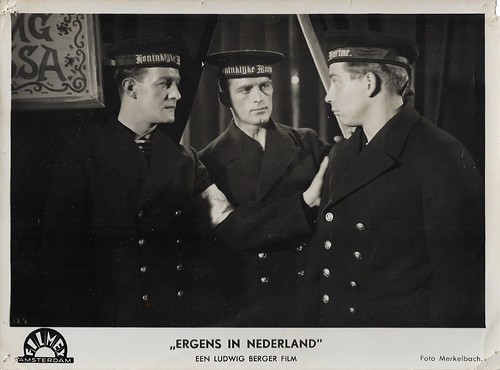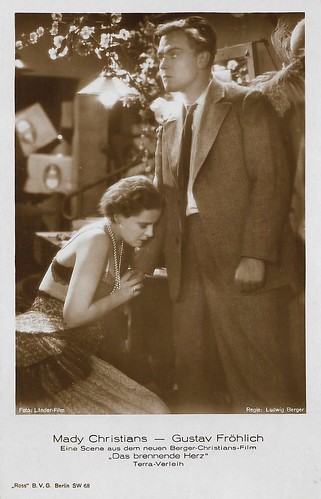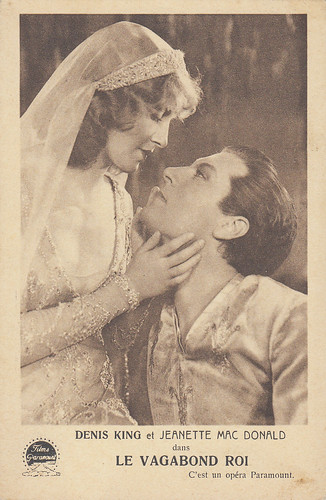
German collectors card by Küno's Film-Foto in the series Der Dieb von Bagdad, no. 2, presented by Sparkasse bank. Photo: publicity still for The Thief of Bagdad (Ludwig Berger, Michael Powell, Tim Whelan, 1940) with John Justin as Ahmad and Sabu as Abu.

German postcard by Ross Verlag, no. 48/2. Photo: Ufa. Willy Fritsch in the German silent film Ein Walzertraum/The Waltz Dream (Ludwig Berger, 1925), based on Oscar Straus's operetta.

Dutch Postcard, no. 74. Photo: Paramount. Maurice Chevalier in Le petit café/Playboy of Paris (Ludwig Berger, 1931).

German postcard by Ross Verlag, no. 192/4. Photo: Ufa. Rose Barsony and Willy Fritsch in Walzerkrieg/Waltz War (Ludwig Berger, 1933).

Dutch film still by Filmex for the film Ergens in Nederland/Somewhere in the Netherlands (Ludwig Berger, 1940), produced by Rudolf Meyer. Photo: Merkelbach. The man on the right is Jan de Hartog.
A sparkling musical comedy
Ludwig Berger was born Ludwig Gottfried Heinrich Bamberger in 1892 in Mainz, Hesse (now Rhineland-Palatinate), Germany. He was the son of Jewish banker Franz Bamberger and Anna Klara Bamberger-Lewino. His father was the Treasury Secretary in the Weimar Republik government of Germany under Otto von Bismarck. His brother Rudolf Bamberger became a famous production designer and stage designer, who died in 1944-1945 in the KZ Auschwitz. Ludwig got a musical education. He studied art history and German language and literature in Munich and Heidelberg. Berger volunteered for the German army when World War I broke out but was released due to periostitis.
Berger launched his artistic career in 1916 as a director at the Stadttheater Mainz with his play 'Gärtnerin der Liebe', an adaptation of Mozart's opera 'La finta giardiniera'. Here, he first worked with his brother, the set designer Rudolf Bamberger, who later collaborated on many of his brother's films. Engagements followed at different German theatres where he was successful with plays by William Shakespeare. Berger also translated a few of Shakespeare's plays, including 'Cymbeline', 'Hamlet', and 'Timon of Athens'.
In 1920 he made his first film, Der Richter von Zalamea/The Mayor of Zalamea (Ludwig Berger, 1920), for which he also wrote the screenplay. It was a historical drama starring Lil Dagover and Albert Steinrück and based on Pedro Calderón de la Barca's historic Spanish play. It was shot at the Babelsberg Studios in Berlin. His breakthrough was the comedy Ein Glas Wasser/A Glass of Water (Ludwig Berger, 1923) with Mady Christians, Lucie Höflich and Hans Brausewetter. The film was very well received both commercially and critically. It is considered one of the milestones of Weimar cinema. It was followed by the Cinderella adaptation Der verlorene Schuh/The Lost Shoe (Ludwig Berger, 1923) with Helga Thomas and Paul Hartmann. The fantasy was produced by Decla-Bioscop which was by then part of the large UFA conglomerate.
A big hit was Ein Walzertraum/A Waltz Dream (Ludwig Berger, 1925) starring Willy Fritsch, Mady Christians and Xenia Desni. It was based on the 1907 operetta 'Ein Walzertraum', composed by Oscar Straus. It was influential in the development of later Viennese operetta films. Unlike many of UFA's ambitious productions of the 1920s, A Waltz Dream managed to recover its production cost in the domestic market alone. The historical comedy Der Meister von Nürnberg/The Master of Nuremberg (Ludwig Berger, 1927) starring Rudolf Rittner, Max Gülstorff and Gustav Fröhlich, was based on the 1868 opera 'Die Meistersinger von Nürnberg' by Richard Wagner. It was considered artistically unsuccessful because of its overly theatrical presentation. After completing the film Berger emigrated to work in Hollywood.
When director Mauritz Stiller was let go and returned to Sweden during the shooting of Street of Sin (Mauritz Stiller, 1928) starring Emil Jannings and Fay Wray, Berger finished the film. In the next years, he could realise more Hollywood productions, like The Woman from Moscow (Ludwig Berger, 1928) starring Pola Negri. Sins of the Fathers (Ludwig Berger, 1928) is an American sound part-talkie drama film produced by Famous Players–Lasky and released by Paramount Pictures. The film stars Emil Jannings and Ruth Chatterton in her film debut. Berger's first sound film was The Vagabond King (Ludwig Berger, Ernst Lubitsch, 1930) starring Dennis King as the poet-rogue Francois Villon. He then directed a sparkling musical comedy with Maurice Chevalier, Playboy of Paris (Ludwig Berger, 1930) and the alternate, French language version Le petit café (Ludwig Berger, 1931).

German postcard by Ross Verlag, no. 48/1. Photo: Ufa. Mady Christians and Willy Fritsch in Ein Walzertraum (Ludwig Berger, 1925), adapted from the Oscar Straus operetta.

German postcard by Ross Verlag, Berlin. Photo: Phoebus Film. Veit Harlan and Julius Falkenstein in Der Meister von Nürnberg/The Master of Nuremberg (Ludwig Berger, 1927).

German postcard by Ross Verlag, no. 3993/1, 1928-1929. Photo: Paramount. Fay Wray in Street of Sin (Mauritz Stiller, Ludwig Berger, 1928).

French postcard by Europe, no. 344. Emil Jannings in Street of Sin (Mauritz Stiller, Ludwig Berger, 1928).

German postcard by Ross B.V.G., unnumbered. Photo: Länder Film. Mady Christians and Gustav Fröhlich in Das brennende Herz (Ludwig Berger, 1929). Terra distributed the film.
Hiding in Amsterdam
Back in Germany, Ludwig Berger directed the enjoyable comedy Ich bei Tag und du bei Nacht/I by Day, You by Night (Ludwig Berger, 1932) about a nightclub waiter (Willy Fritsch) and a manicurist (Käthe von Nagy) who share the same room. He sleeps there by night and she by day. Then he made his most successful film, Walzerkrieg/Waltz War (Ludwig Berger, 1931), with Renate Müller and Willy Fritsch. The story is about the musical rivalry between Joseph Länner and Johan Strauss and their respective waltz orchestras in Vienna in the first half of the 19th century. The film is dominated by Waltz music, dance and song. Walzerkrieg is one of the highlights of early German sound film operettas and marks a decisive point for German film production in socio-political terms.
Even before filming began, there was a special meeting of the Ufa Board on 29 March 1933 to discuss the continued employment of Jewish employees. The day before, Joseph Goebbels gave a speech before several filmmakers. Ufa obediently complied with the expectations of the Nazi regime even before it had passed the first anti-Semitic laws and regulations. The Ufa Board of Directors dismissed 20 employees, including people working on Walzerkrieg. The script by Hans Müller and Robert Liebmann was still accepted in 1932, but the authors were immediately fired. The studios also wanted to fire director Ludwig Berger, but his contract with Ufa had already been signed. The head of the Ufa Orchestra, Werner Richard Heymann, received an offer to stay but decided not to accept and emigrated to Paris. At the film's premiere on 4 October 1933, neither the scriptwriters, the director nor actor Adolf Wohlbrück were mentioned in the opening credits.
In 1935, Ludwig Berger left Nazi Germany and emigrated to England via France and the Netherlands. Soon afterwards, however, he returned to Germany, where he lived in seclusion in Schlangenbad. In the Netherlands, he made the film Pygmalion (Ludwig Berger, 1937) starring Lily Bouwmeester and based on the 1913 play by George Bernard Shaw. The story, about an Amsterdam flower girl who receives speech lessons from a distinguished speech teacher, struck a chord with the press and the public. Pygmalion is considered one of the most successful Dutch prewar films. Berger tried to get commissions in Paris and London but could only realise Les trois valses/Three Waltzes (Ludwig Berger, 1938) with Pierre Fresnay and his wife Yvonne Printemps.
Berger settled in Amsterdam in 1938 with forged papers to mask his Jewish roots. His house in Schlangenbad had been secured with an administrator. He wrote the text for the mass-mounted historical occasional play 'Eenheid door Oranje' (Unity through Orange), directed by Eduard Verkade. The play premiered at the Elswout estate in 1938 to mark the 40th anniversary of Queen Wilhelmina's reign. In the United Kingdom, he co-directed The Thief of Bagdad (Ludwig Berger, Michael Powell, Tim Whelan, 1940) for Alexander Korda. Berger was originally contracted as the sole director of the lavish adventure film, but got into a dispute with producer Korda and had to hand over much of the filming to Michael Powell and Tim Whelan. Back in the Netherlands, he directed Ergens in Nederland/Somewhere in the Netherlands (1940) with Lily Bouwmeester and Jan de Hartog. During the occupation, Ergens in Nederland was one of the first films banned in July 1940. A re-premiere took place immediately after the liberation in May 1945. In 1940, Ludwig Berger went into hiding in Amsterdam but continued teaching young Dutch talent. During the Hunger Winter of 1944, Berger directed Shakespeare's 'A Midsummer Night's Dream', among other plays. The performance was shown illegally in the sitting room of his home on Amsterdam's Vondelstraat. In 1945, the painter Max Beckmann, who was living in exile in the Netherlands, created his portrait.
After the war, Ludwig Berger made long trips. He returned to Germany in 1947. Three years later he realised his first post-war film with Ballerina/Dream Ballerina (Ludwig Berger, 1950) with Violette Verdy and Gabrielle Dorziat. This was also his last feature film. From then on he worked for television. He made a special contribution to television drama of which he was one of the pioneers. Among his TV movies were Die Spieler/The Gamblers (1954) after Nikolay Gogol, Undine/Ondine (1955) based on Jean Giraudoux, and Plato's Der Tod des Sokrates/Phaedo (1957). Berger also directed several William Shakespeare plays for TV, including Viel Lärm um nichts/Much Ado About Nothing (1958) with Jan Hendriks, Maß für Maß/Measure for Measure (198) with Alexander Kerst and Ein Sommernachtstraum/A Midsummer Night's Dream (1958) with Gardy Granass and Ingrid Stenn. Occasionally he appeared as an actor, usually in smaller roles, such as in 'So weit die Füße tragen' and 'Am grünen Strand der Spree'. He worked as a theatre and radio play director and wrote several plays, prose and monographs. In 1964 he was awarded the Deutscher Filmpreis, the Gold Film Ribbon for many years of outstanding work in German film. In 1966 followed the Großes Verdienstkreuz, the Grand Cross of Merit with the Star of the Order of Merit of the Federal Republic of Germany. His last TV movie was Demetrius (Ludwig Berger, Heribert Wenk. 1969) based on 'Demetrius' by Friedrich Schiller. Ludwig Berger died of heart failure in 1969 in Schlangenbad. He was 77. Berger is buried in the Mainz-Mombach forest cemetery.

Belgian postcard. Photo: Films Paramount. Jeanette MacDonald and Dennis King in The Vagabond King (Ludwig Berger, 1930). Collection: Marlene Pilaete.

Dutch postcard, no. 93. Photo: Paramount. Frances Dee and Maurice Chevalier in The Playboy of Paris (Ludwig Berger, 1930).

French postcard. Photo: Paramount. Maurice Chevalier in Le petit café/Playboy of Paris (Ludwig Berger, 1931). Collection: Geoffrey Donaldson Institute.

German collectors card in the series 'Vom Werden deutscher Filmkunst - Der Tonfilm', album no. 11, picture no. 35, group 44. Photo: Ufa / Ross Verlag. Willy Fritsch learns the young Queen of England Hanna Waag to waltz in Walzerkrieg/Waltz War (Ludwig Berger, 1933).

Dutch film still by Filmex for Ergens in Nederland (Ludwig Berger, 1940), produced by Rudolf Meyer. Photo: Merkelbach. Left Jan de Hartog, right Matthieu van Eysden.

British postcard in the Colourgraph Series, London, no. C 340. Photo: Alexander Korda Productions. John Justin as Ahmad and June Duprez as the Princess in The Thief of Bagdad (Ludwig Berger, Michael Powell, Tim Whelan, 1940).
Sources: Arts in Exile, Wikipedia (Dutch, German and English) and IMDb.
No comments:
Post a Comment